Iceland have been drawn into Group D for this summer’s European Championships along with Belgium, France and Italy. All sides rank in the top 20 of the FIFA world rankings, making it a potentially difficult group to navigate. Having qualified for a major international tournament for just the fourth time ever, Iceland will be looking forward to making a mark on the tournament. Previously, Iceland have only progressed out of the group stages once — in 2013, when they reached the quarter-finals. Manager Thorsteinn Halldórsson will be filled with confidence following a positive performance at this year’s SheBelieves Cup, in which they finished second to the United States.
The Icelandic squad contains several talented and experienced players, such as Sara Björk Gunnarsdóttir of Olympique Lyonnais, Dagny Brynjarsdóttir of West Ham and veteran midfielder Gunnhildur Yrsa Jónsdóttir from Orlando Pride. These key players will have vital contributions to make for whatever Iceland go on to achieve this summer. Several young players will be hoping to make an impact on their performance. Goalkeeper Cecilía Rán Rúnarsdóttir who has recently joined Bayern Munich and tricky winger Sveindis Jane Jónsdottir who has had an outstanding campaign with Wolfsburg in the Bundesliga.
The team qualified relatively comfortably by finishing second in the qualification group. Along with this, Iceland only lost once and finished just three points behind first-placed Sweden. Iceland played group member Italy back in 2021 over two back to back games. The first was a 1-0 loss, the second a 1-1 draw. This fixture is certainly one that will be closely contested.
Head coach Thorsteinn Halldórsson has led his side to 15 wins and just two losses during his time in charge. Most recently, a runners-up finish in the SheBelieves Cup proved a huge triumph, with Iceland beating New Zealand and the Czech Republic on their way. Halldórsson has his side playing with confidence and possesses a good mix of youth and experience heading into the Euros.
This article will be a tactical analysis preview of Iceland going into Euro 2022 in the form of a scout report. It will be an analysis of the sides tactics to try and predict how the Icelanders will line up this summer.
Predicted Starting XI
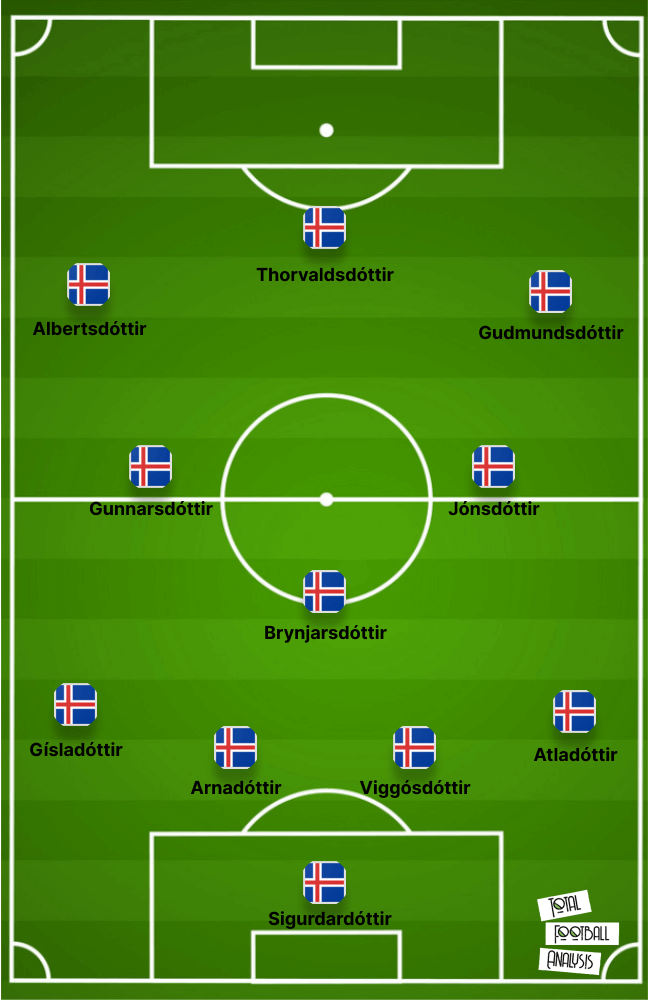
Halldórsson has been very rigid in his starting formation, using the 4-3-3 for every game bar one in 2022. It’s clear that the coach prefers the 4-3-3 over other formations as he gets a good balance between defensive coverage, midfield dominance and attacking prowess. He operates his side in a way that asserts themselves as the dominant team and controls possession.
Sandra Sigurdardóttir is likely to be the first-choice goalkeeper; the 35-year-old provides experience with 41 international caps. Meanwhile, the second-choice keeper will be up-and-coming stopper Cecilía Rán Rúnarsdóttir who has recently moved to Bayern Munich. The 18-year-old has already represented her country 7 times, so don’t be surprised if she ends up in between the goalposts at some stage. Glódis Perla Viggósdóttir and Gudny Arnadóttir could line up in the centre of defence, though the pairing is relatively young. Arnadóttir has spent the season on loan at Napoli in the Serie A. Veteran fullbacks Hallbera Gudny Gísladóttir on the left and Sif Atladóttir on the right will add experience and composure to the young centre-back pairing.
In the midfield, Sara Björk Gunnarsdóttir is set to captain the side. The two-time Champions League winner brings quality and excellent discipline to the midfield. In the centre, she will be joined by Dagny Brynjarsdóttir and either Gunnhildur Yrsa Jónsdóttir, Alexandra Jóhannsdóttir or Karólína Lea Vilhjálmsdóttir. Jónsdóttir is 33 now and her minutes seem to be managed well by Halldórsson. The last 2 of the potential 3 both play their football in Germany and bring youthful energy to the side. Onto the front line, which is led centrally by Berglind Björg Thorvaldsdóttir, who is joined by Sveindis Jane Jónsdottir on the right and Agla María Albertsdóttir on the left. Elín Metta Jensen is in serious contention for a starting position here as well. The 27-year-old has 16 international goals for the Icelandic national team — so is a significant goal threat. Halldórsson fills his squad with depth and adaptability. He has a range of different attackers and can use them to combat different opponents.
When looking at the age of the squad, its average is 26.4 years old. The squad has 6 players over the age of 30 and 7 under the age of 23. The age of the squad and experience is mixed well with 4 of the players having over 100 caps for their nation.
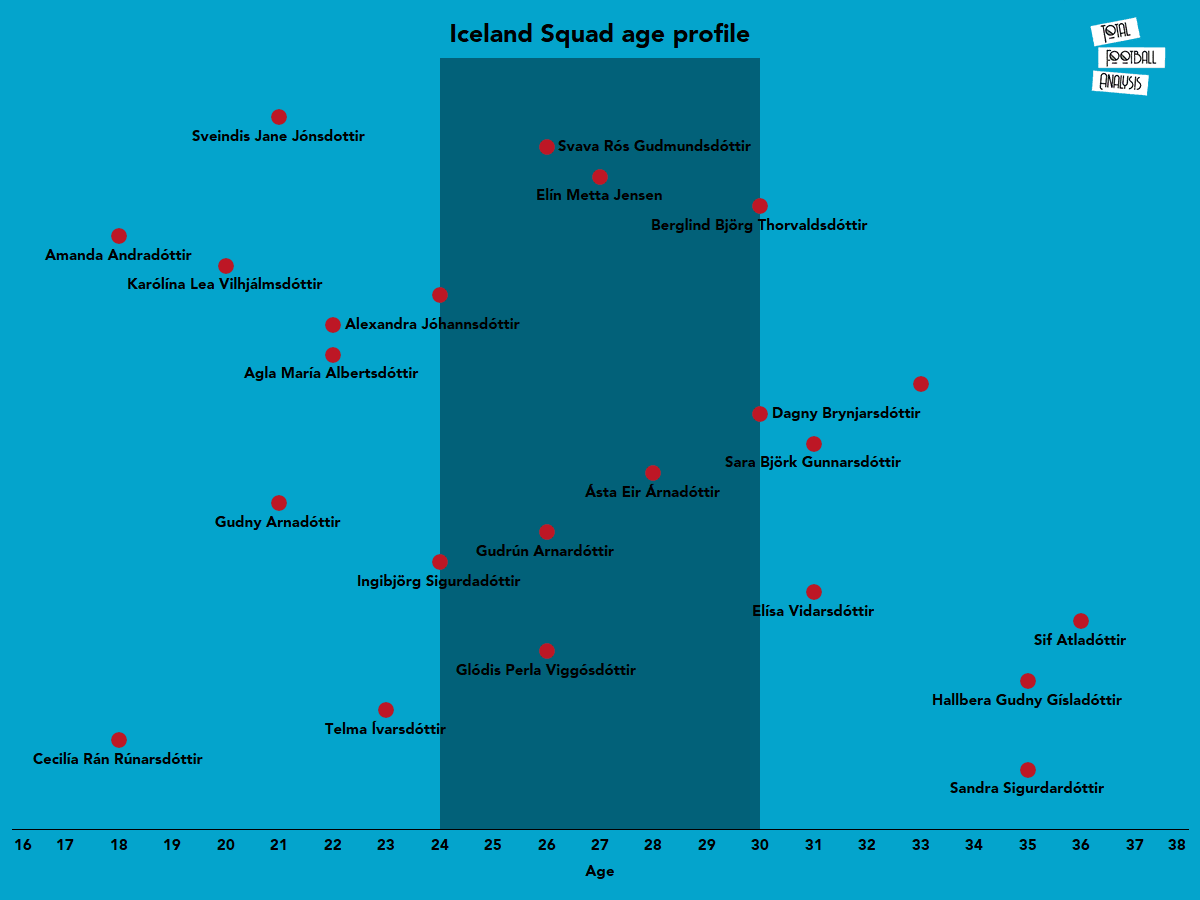
The graphic above is split into three sections, youth (aged 24 and under), peak (24 to 30) and experienced (30 and over). As seen, Iceland have a large mix of youth and experience. The squad does favour the youthful players slightly and the majority have played a high volume of minutes. The youthfulness of the squad mixed well with those at their peak will be helpful in the way Iceland patiently play.
Attacking Phase
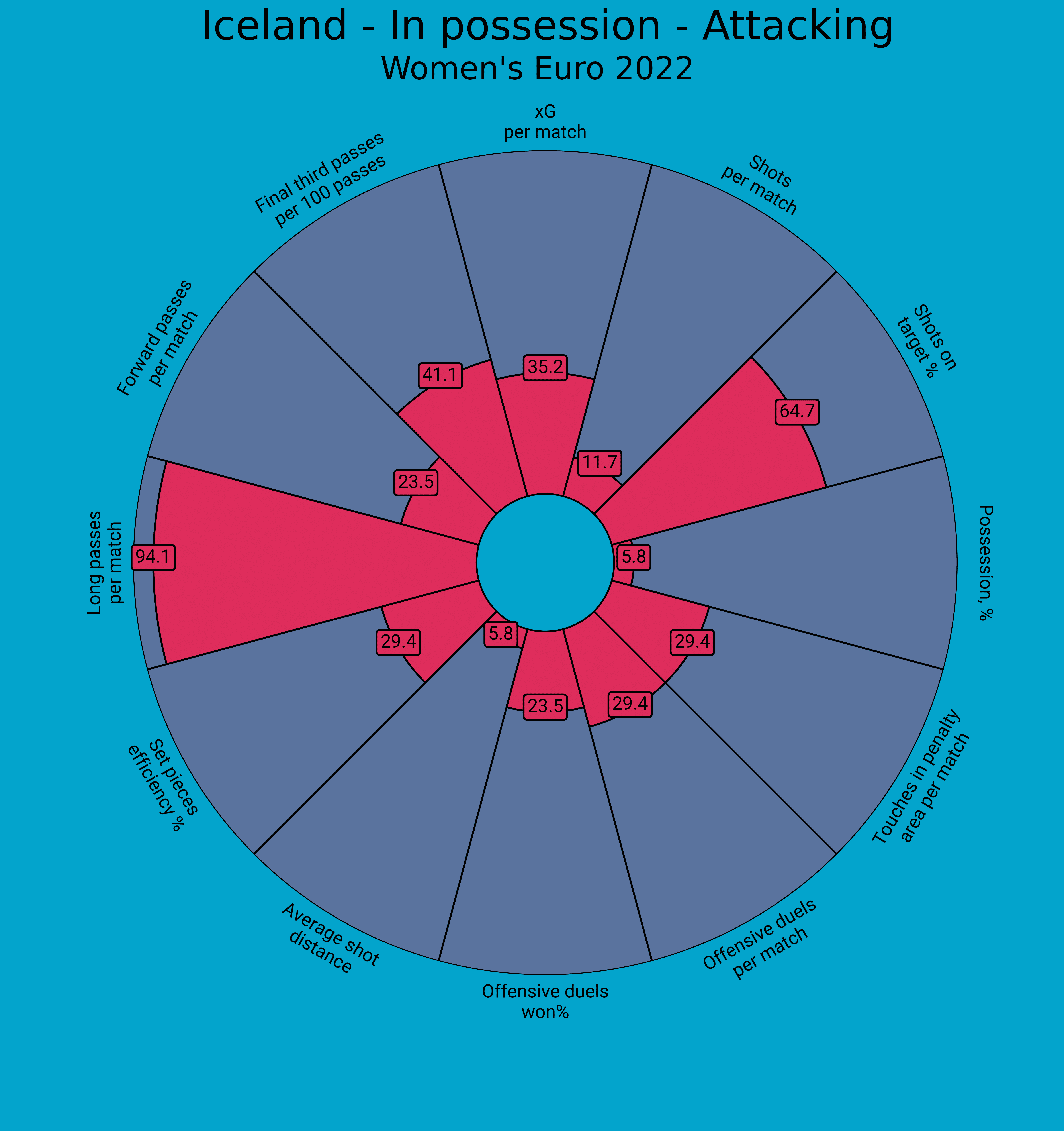
Iceland’s attacking phase is fairly one-dimensional, with their long passes per match standing out massively on the graph. A clear set way of playing has been drilled into them by boss Thorsteinn Halldórsson, this is evident as the other attacking areas seem to lack in the data. Iceland look to play long; by doing this, they avoid any high press that the opposition will attempt. The long ball tactic has been worked on as Iceland are great at positioning themselves perfectly to retain possession following a long pass. Another area in which Iceland have scored quite highly is their shot accuracy rate. Just under two-thirds of Iceland’s shots are on target, which is a positive stat when it comes to scoring goals. Iceland frequently create good shooting opportunities which leads to a high percentage of shots on target.
A large emphasis is placed upon Iceland’s midfield as it is arguably their strongest area on the pitch. However, the possession stats seem concerning when considering this. Iceland may benefit from setting up in a way that can allow for their experienced midfield to dominate and keep possession more comfortably. Along with this, Iceland’s stat for forward passes is, again, worrying low. Now, this stat can be explained easier as it goes hand in hand with Iceland’s long ball method. Whilst Iceland play one long direct pass, other teams may build up with four or five forwards passes, so this statistic can be slightly overlooked but must still be considered.
In their attacking phase, Iceland look to create clear-cut goal-scoring opportunities. This is done in several ways, most commonly via cutbacks. Below is shown how Iceland intend on getting into goalscoring positions. One player makes a run across the goal, dragging defenders with them. This, in theory, should create space towards the top of the penalty area for a midfield player to arrive and have a clear chance to score. If perfectly timed, this move can lead to lots of goals and is a positive tactic used by Iceland.
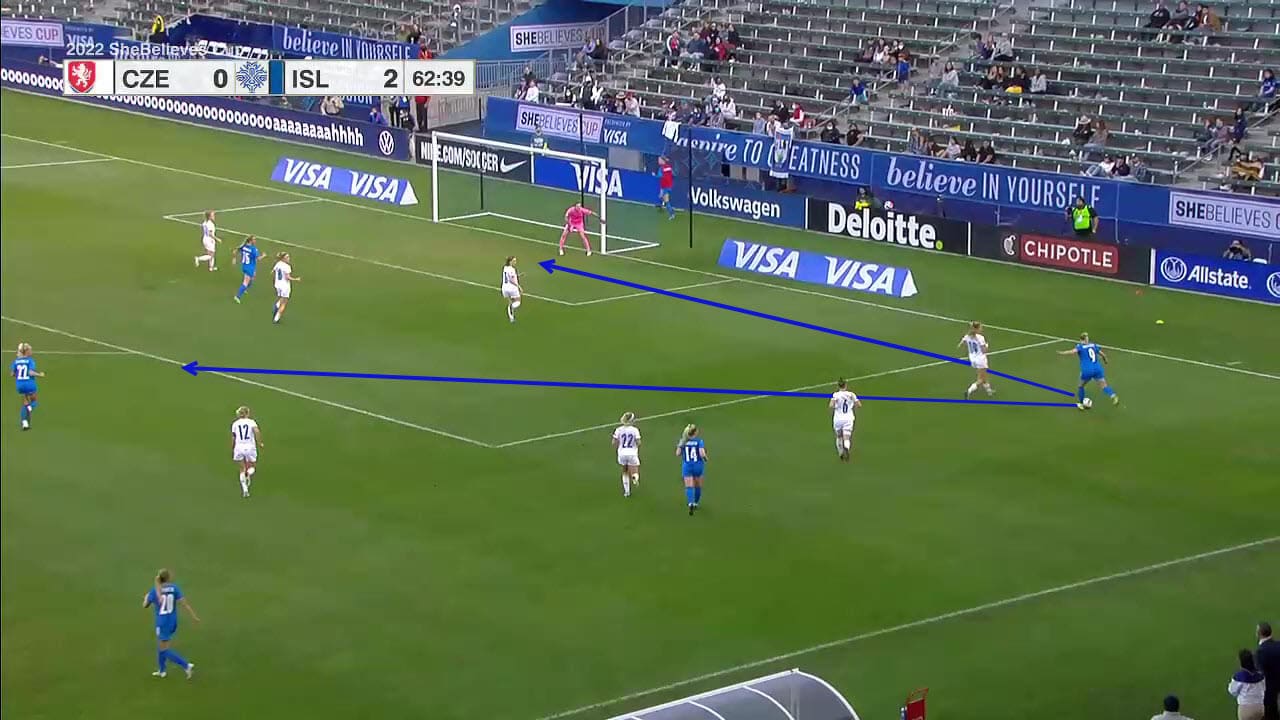
Another way that Iceland look to attack is via a long ball. As seen in the data, a long ball is something the Halldórsson’s side is well used to. Iceland are effective at creating chancing following a long ball. By playing a long ball, Iceland look to quickly and directly progress play. Something which needs to be consistent is the number of supporting players around the target of the long ball. Getting support around the target allows for quick capitalisation of disruption to the opposition and can help exploit space which may have been discovered. Below is an example of how a simple setback following a long ball can create excellent goal-scoring chances.
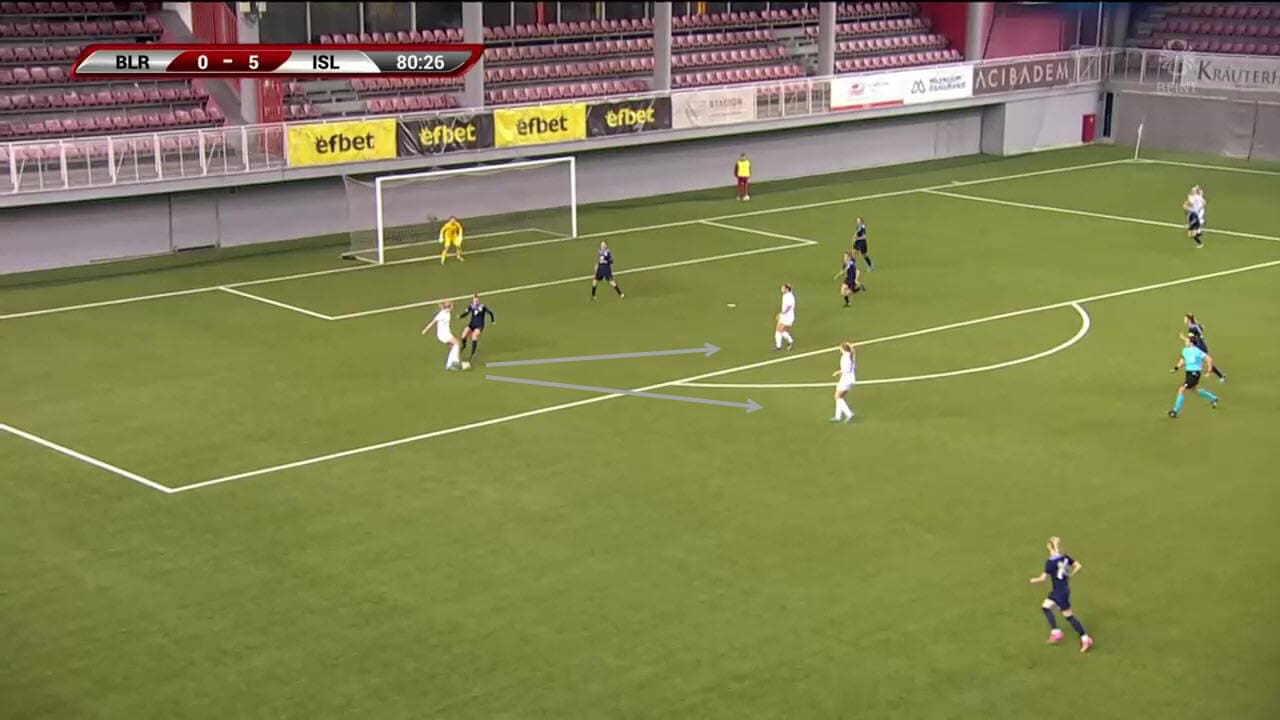
Another huge part of Iceland’s attacking phase is the team’s renowned long throw. This is something the men’s team made headlines for in previous years and I am certain at the 2022 Euros, the women’s team will make it their own. Iceland can load the box with players and set it up like a corner kick. The long throw is something that Iceland have used very effectively in the past, scoring two goals from their long throw-ins in their last four games. By loading the box with their players Iceland look to aerially dominate teams and make the first contact. This tactic causes drama and unrest for the opposition defenders — and is definitely something to watch out for in this tournament.
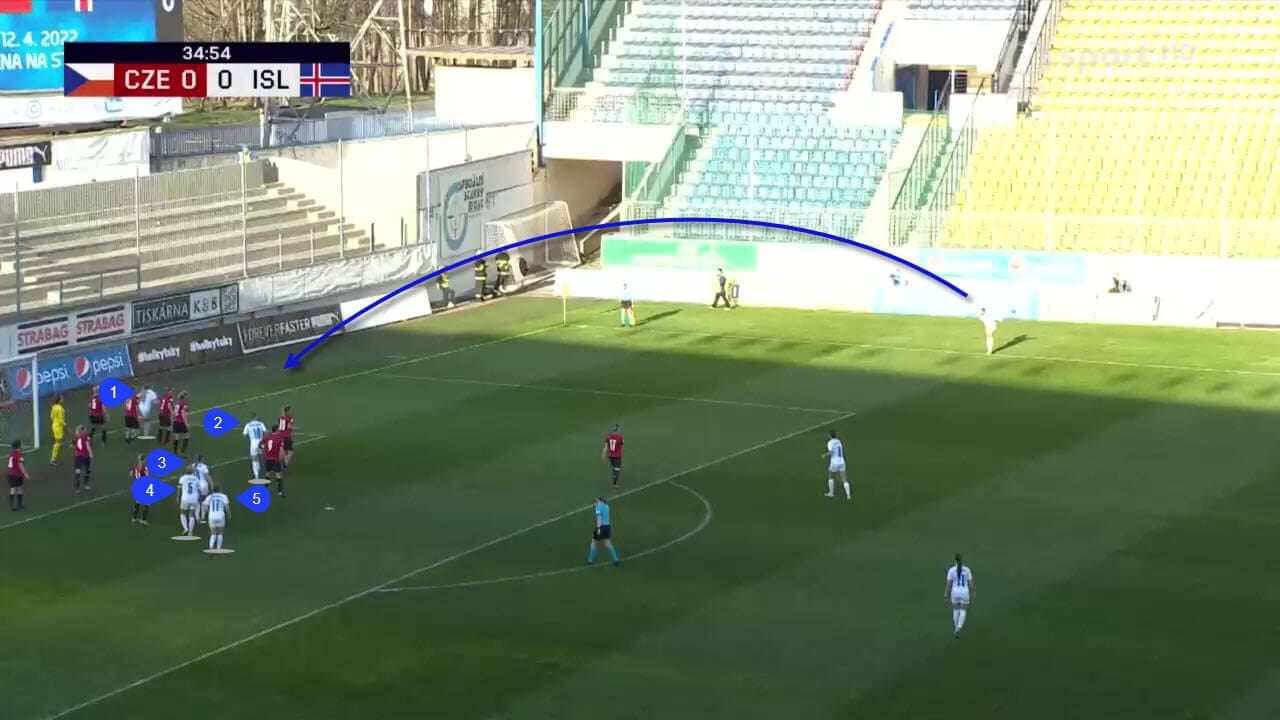
Defensive Phase
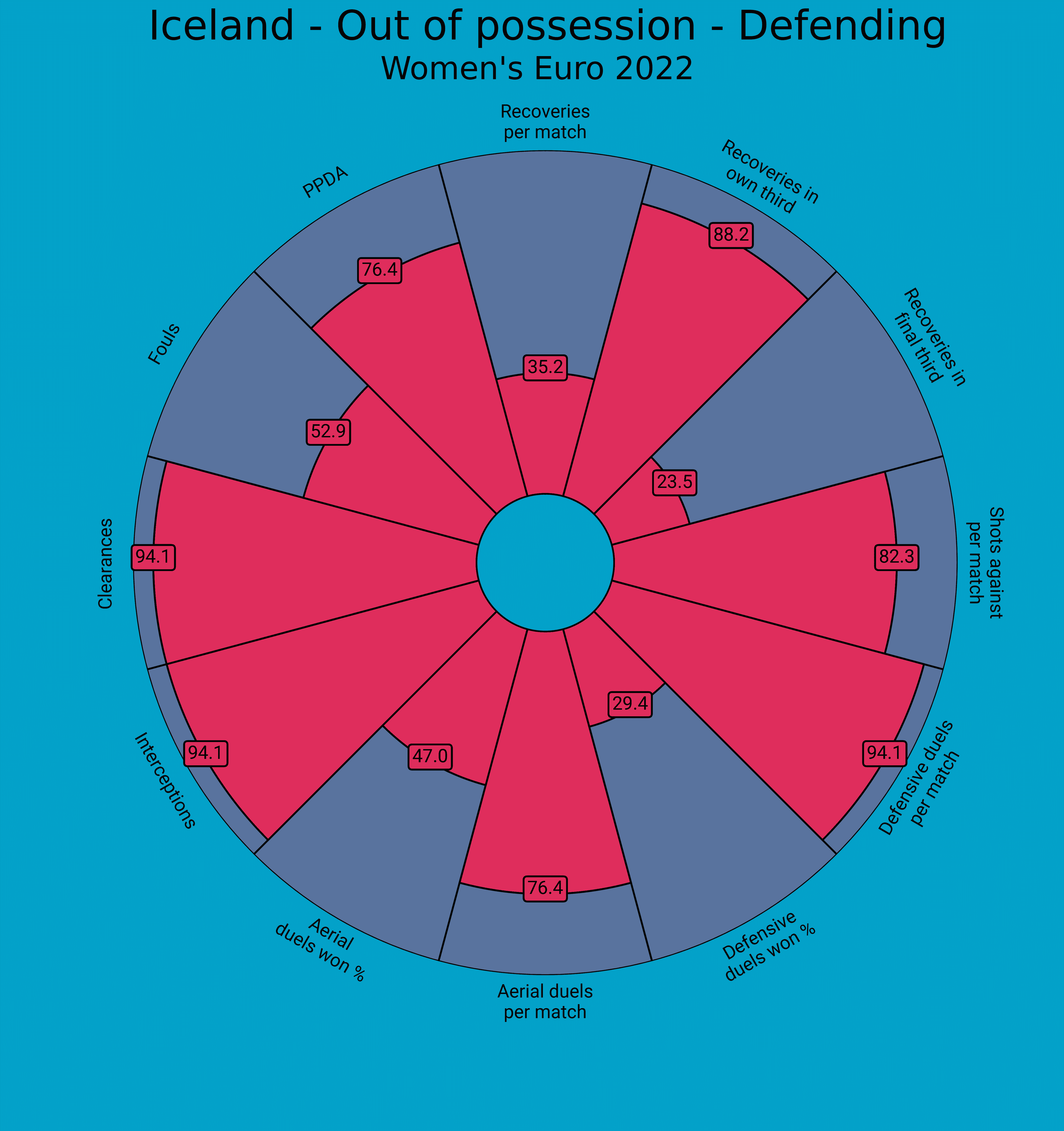
Iceland have been very defensively solid since boss Halldórsson has taken over, keeping eight clean sheets in their last 10 matches, including World Cup Qualification matches and the SheBelieves Cup; they boast an impressive defensive record which Iceland can pride themselves on and is a great base to build a successful team upon. Looking at the data, Iceland score highly in clearances and interceptions. These statistics can go directly down to Iceland’s out-of-possession shape and discipline.
When defending from the front, Iceland do not press aggressively and much prefer to direct play to an area or space via their organised and disciplined shape. ‘The recoveries in final third stat’ ranking at such a low percentile shows Iceland are not a high pressing side. Below is an example of how Iceland set up when the ball is high up the pitch. The wingers occupy an opposition player and the striker directs play to force a longer or riskier pass.
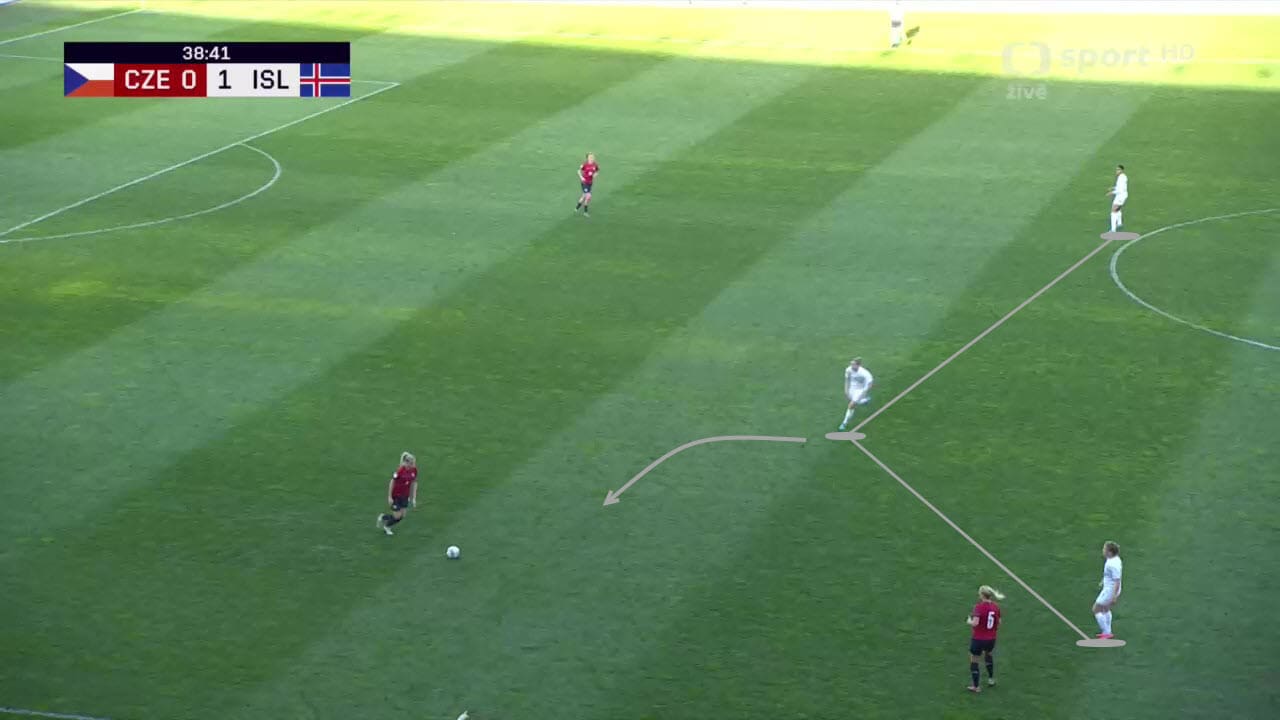
Iceland set up in a 4-5-1 shape which is easily transitioned into from a 4-3-3 as the wingers drop deep to create a bank of 5 across the midfield. By operating in a 4-5-1, Iceland compact the central area of the pitch with the ability to match player-for-player alongside opposition midfielders. The 4-5-1 keeps Iceland compact and rigid. The three central midfield players monitor the space between the lines and one of them usually drops deeper to ensure protection for the back four.
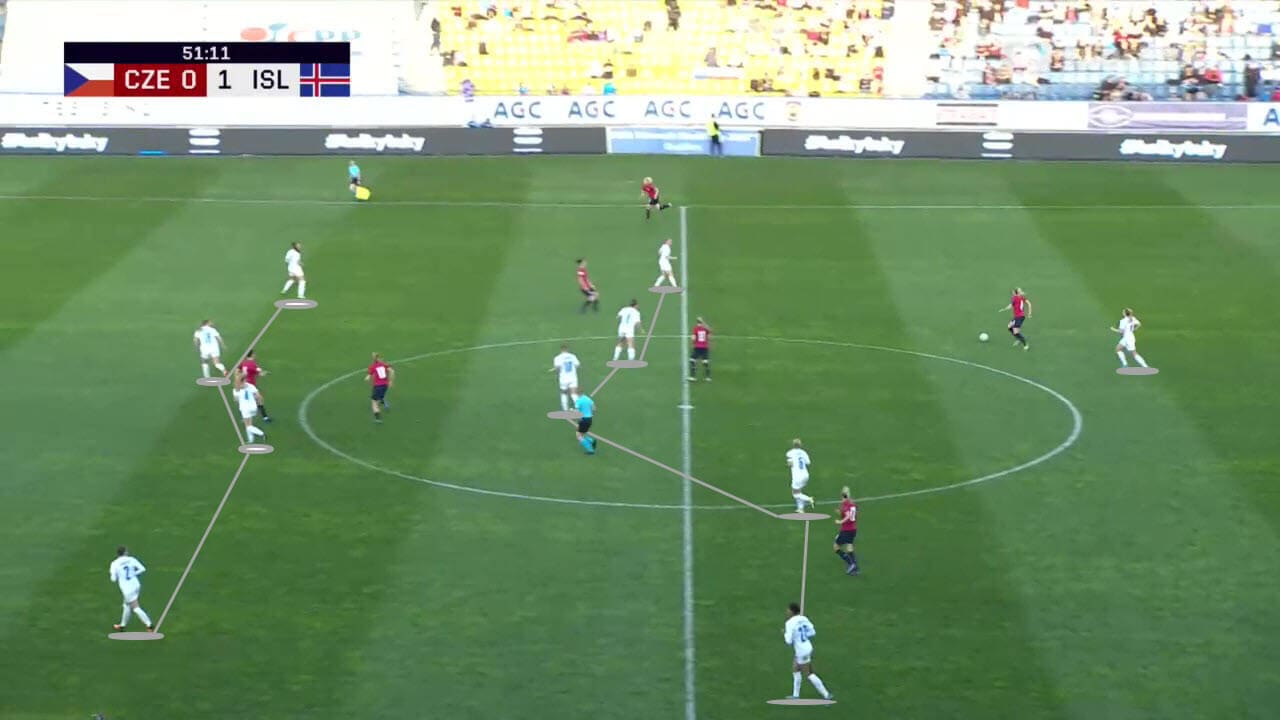
The Iceland midfield is disciplined and good at disrupting play, the team score very highly on interceptions and recoveries in their own third, which proves how defensively solid they are. The recoveries in their own third stat at 88.2 emphasises how much Iceland focus on defending passively in the early stages of the defensive phase and winning the ball back closer to their own goal when the opponent has been drawn forward. By almost disregarding the press, Iceland can regain their shape and make themselves difficult to break down.
A worrying sign of Iceland’s defensive capabilities is their defensive duels numbers. Iceland have a very high percentile ranking for defensive duels per match, at 94.1. This stat is followed up by a very poor percentile of defensive duels won at 29.4 — a concerning stat for Iceland as teams may look to target them 1v1. With ageing fullbacks Hallbera Gudny Gísladóttir and Sif Atladóttir being 35 and 36, respectively, this is an area that should be monitored and watched.
Transitions
Iceland’s offensive transition look to regain and sustain possession rather than catching the opposition with a quick counterattack. Once Iceland have the ball, they look to break forward but wait for support to ensure the safety of the ball. Below is an example of how Iceland choose to keep possession rather than attack quickly. Many teams would play the ball in behind for their striker to run onto but Iceland play the ball infield, which is a safer move.
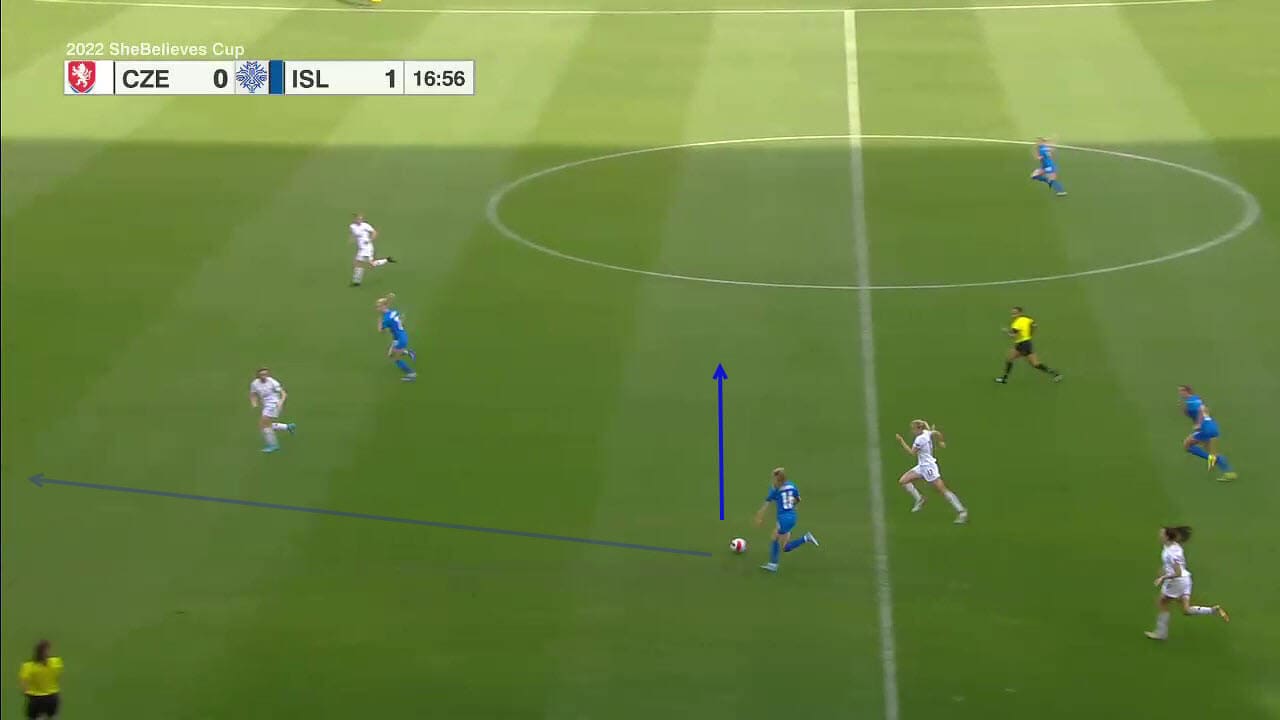
On defensive transition, Iceland are quite conservative and do not over-commit themselves to any challenges that could leave them exposed. As previously mentioned, Iceland are not a high-pressing side. Pictured is an example of how Iceland monitor the situation but do not directly look to apply a huge amount of direct pressure to the situation.
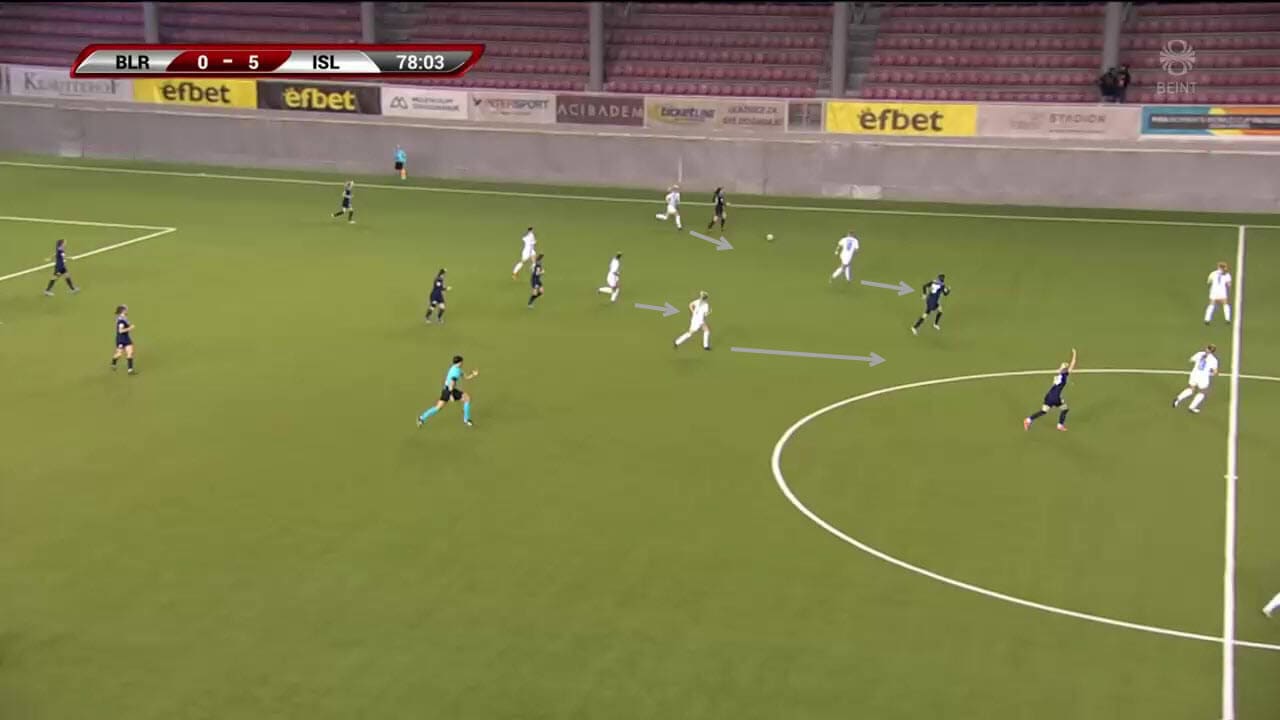
Forwards
Iceland’s attacking options will be made up of the likes of Berglind Björg Thorvaldsdóttir, Sveindis Jane Jónsdottir and Agla María Albertsdóttir. The attack features a very solid striker in Thorvaldsdóttir, who has found the net 10 times for her country. Along with the front three, another attacker who is in contention for a place is Elín Metta Jensen, who plays her football for the Icelandic team Valur. The 27-year-old has made 59 appearances for her country. With the pacey wingers in the side, Iceland certainly will pose a threat for most teams. Their wing play and link-up between the front three is something that can see them easily slice through defences.
Midfielders
Iceland’s midfield is arguably the strongest area in their squad, with five midfielders all in contention for starting in the midfield three. This consists of Champions League winner and captain Sara Björk Gunnarsdóttir, West Ham midfielder Dagny Brynjarsdóttir who likes to get on the ball and link play — her ability and calmness on the ball allow for Iceland to progress easily — and Brynjarsdóttir, who loves to demand the ball from her teammates, especially the central defenders; she is always an option to pass to.
Defenders
The defence of Iceland is an area mixed with plenty of experience and youth. Defenders Glódis Perla Viggósdóttir, Hallbera Gudny Gísladóttir and Sif Atladóttir have over 300 international caps between them. This gives the Icelandic team a great base of experience to build upon. Then, 26-year-old Glódis Perla Viggósdóttir is a key part of the heart of the Icelandic defence. Young defender Gudny Arnadóttir is likely to complete the back four. Elísa Vidarsdóttir and Ingibjörg Sigurdadóttir provide cover for the defence; both could come into the back four comfortably.
Best Performer
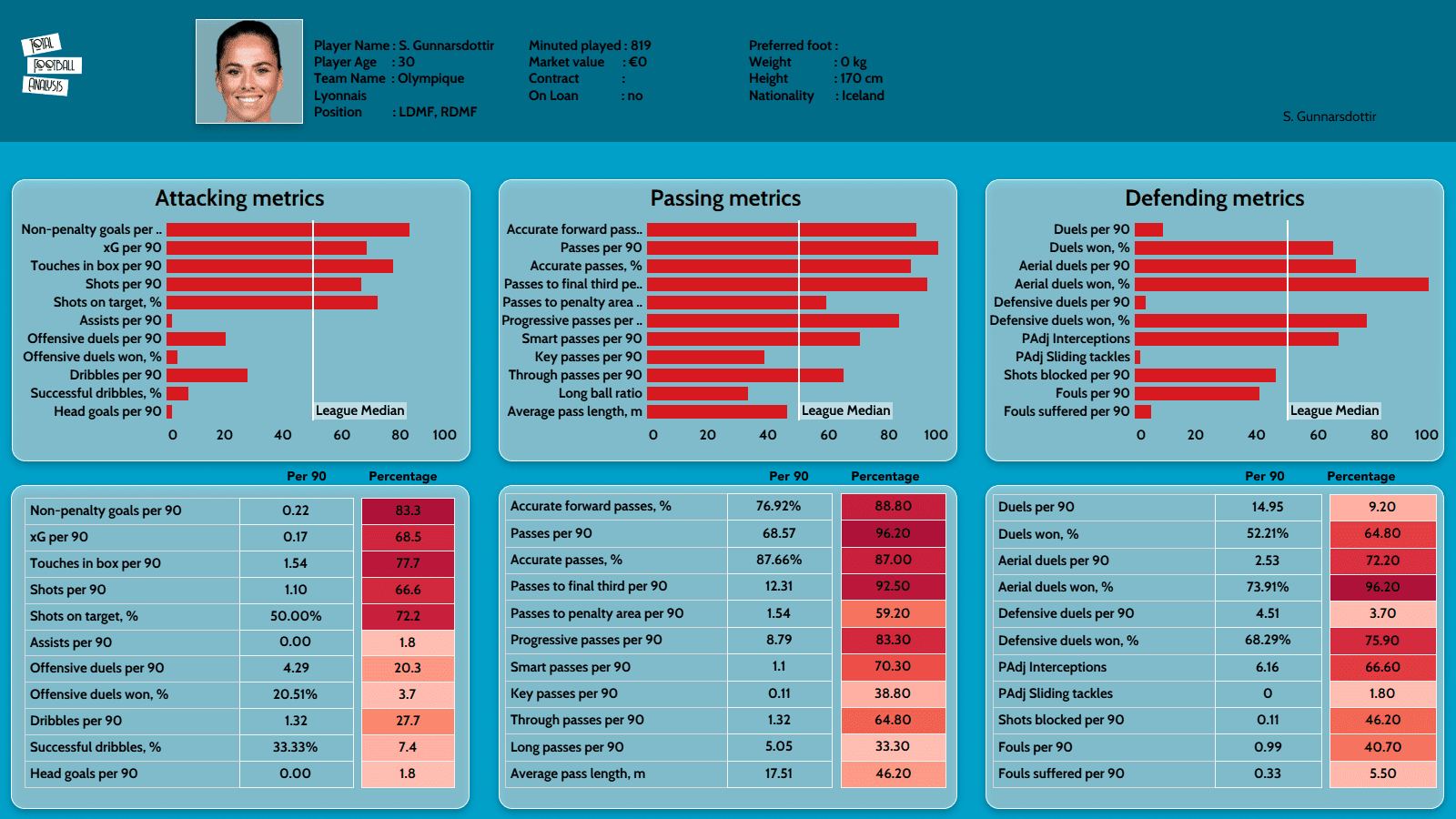
Sara Björk Gunnarsdóttir has been at the top of the women’s game for several years. Playing regularly in the Lyon midfield is no easy feat and the tenacious midfielder has an outstanding all-around game. There is no doubt that Gunnarsdóttir will be key to Iceland’s success in this competition. The midfielder has recently come back from maternity leave early to ensure her fitness for this summer’s competition.
Attacking-wise, the Lyon midfielder is far above the league average in key areas such as touches in the box per 90, shots per 90 and percentage of shots on target. Her ability to take chances and become an attacking threat from central midfield is something that Iceland must allow her to do. The ability to have a midfielder with high attacking output is of huge value, especially in tournament games when ties can be close. Sara Björk Gunnarsdóttir has 22 international goals in 138 appearances.
Possession-wise, again, Sara Björk Gunnarsdóttir is outstanding — scoring way above average in eight out of the 11 metrics measured on our graph. The ability to progress play forward into the final third and penalty area will enable Iceland to have that cutting edge when breaking sides down. The percentage of accurate forward passes is a key area which should be highlighted; scoring a score of 76.92%, Gunnarsdóttir is certainly capable of controlling a game.
Finally, Gunnarsdóttir’s defensive stats. Again an area of high class, especially aerially. Gunnarsdóttir ranks almost above everyone else in her league on the percentage of aerial duels won per 90. She will add some defensive steel and discipline to the side. She ranks extremely well for interceptions, highlighting her ability to read the game and play defensively in a system.
Tournament Ptrediction
Iceland find themselves in a difficult group, competing with France, Italy and Belgium. A win in their first game against Belgium will put them in a strong position to progress. The game to focus on for Iceland will be the Italy game. Italy and Iceland will both be confident of gaining the runners-up spot. France are clear favourites for the group but don’t write Iceland off. If they progress by finishing as runners-up, they will face Group C winners — likely to be the tournament holders, Netherlands or FIFA’s world number 2, Sweden. Advancing to the knockout stage of the tournament would be a great success for Iceland, and this is where they will aim to progress to.

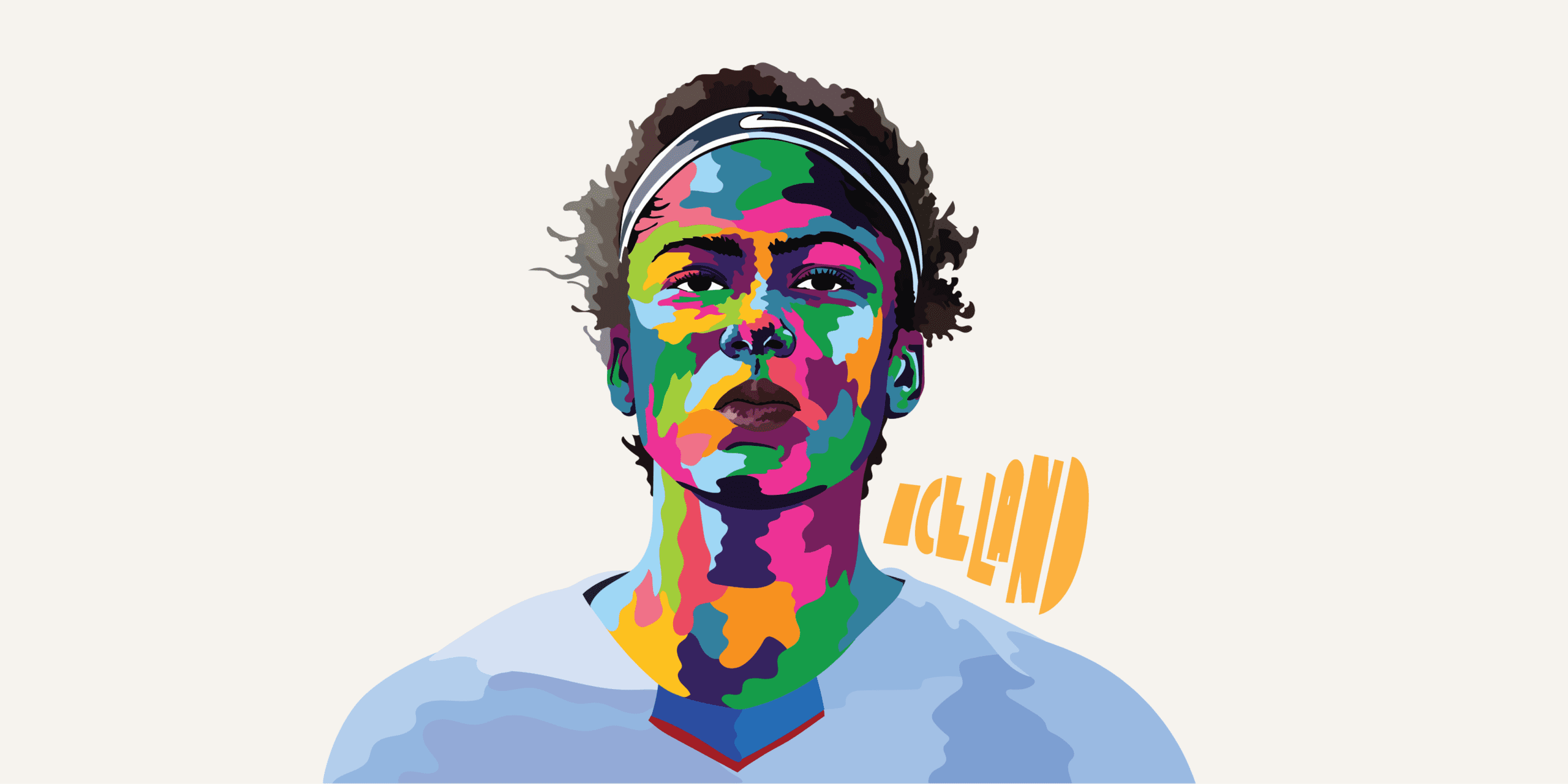


Comments